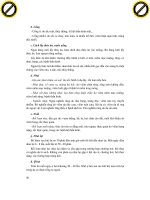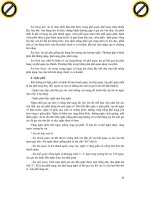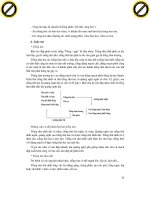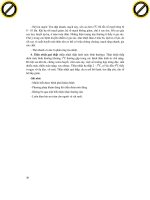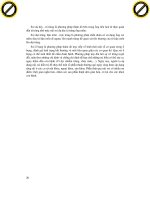- Trang chủ >>
- Y - Dược >>
- Y học công cộng
Những cập nhật trong khuyến cáo bệnh van tim AHA ACC 2017
Bạn đang xem bản rút gọn của tài liệu. Xem và tải ngay bản đầy đủ của tài liệu tại đây (1.11 MB, 35 trang )
Những cập nhật trong
khuyến cáo bệnh Van tim
AHA/ACC 2017
Bs. Nguyễn Văn Thảo
Khoa Phẫu thuật Tim - Bệnh viện Chợ Rẫy
Nguyễn Thành Khoa
Trường Đại học Y Dược Huế
Mức khuyến cáo
và mức độ bằng
chứng đối với các
Chiến lược lâm
sàng, Can thiệp,
Điều trị hoặc Test
chẩn đoán trong
chăm sóc bệnh
nhân
(cập nhật 8/2015)
Các giai đoạn tiến triển bệnh van tim
Stage
A
B
C
D
Definition
Description
Patients with risk factors for the development of
At risk
VHD
Patients with progressive VHD (mild-to-moderate
Progressive
severity and asymptomatic)
Asymptomatic patients who have reached the
criteria for severe VHD
Asymptomatic
C1: Asymptomatic patients with severe VHD in
severe
whom the left or right ventricle remains
compensated
C2: Asymptomatic patients who have severe VHD,
with decompensation of the left or right ventricle
Symptomatic Patients who have developed symptoms as a result
severe
of VHD
3
Những điểm chính
1. Dự phòng viêm nội tâm mạc nhiễm khuẩn
2. Chống đông trong rung nhĩ
3. Hẹp van động mạch chủ
4. Hở van hai lá nguyên phát
5. Hở van hai lá thứ phát
6. Lựa chọn van nhân tạo
7. Liệu pháp chống huyết khối cho van nhân tạo
8. Hẹp van nhân tạo
9. Hở van nhân tạo
10. Viêm nội tâm mạc nhiễm khuẩn
4
Dự phòng viêm nội tâm mạc nhiễm khuẩn
Recommendations
COR LOE
Modified: Prophylaxis against IE is reasonable before dental
procedures that involve manipulation of gingival tissue,
manipulation of the periapical region of teeth, or perforation of the
oral mucosa in patients with the following:
1. Prosthetic cardiac valves, including transcatheter-implanted
prostheses and homografts.
2. Prosthetic material used for cardiac valve repair, such as
annuloplasty rings and chords.
IIa
C-LD
3. Previous IE.
4. Unrepaired cyanotic congenital heart disease or repaired
congenital heart disease, with residual shunts or valvular
regurgitation at the site of or adjacent to the site of a prosthetic
patch or prosthetic device.
5. Cardiac transplant with valve regurgitation due to a structurally
abnormal valve
5
Dự phòng viêm nội tâm mạc nhiễm khuẩn
• Hiện nay, kháng sinh dự phòng trước các thủ thuật
nha khoa cũng được khuyến cáo cho các bệnh nhân
sử dụng chất liệu nhân tạo để sửa van (như là vòng
van annul hoặc dây chằng nhân tạo)
• Mức chứng cứ cập nhật từ B sang C-LD
6
Chống đông trong rung nhĩ
Recommendations
COR LOE
New: Anticoagulation with a VKA is indicated for patients
I
B-NR
with rheumatic mitral stenosis and AF
New: Anticoagulation is indicated in patients with AF and
a CHA2DS2-VASc score of 2 or greater with native aortic
I
C-LD
valve disease, tricuspid valve disease, or MR
New: It is reasonable to use a DOAC as an alternative to a
VKA in patients with AF and native aortic valve disease,
IIa
C-LD
tricuspid valve disease, or MR and a CHA2DS2-VASc score
of 2 or greater
7
Chống đông trong rung nhĩ
Recommendations
COR LOE
New: Anticoagulation with a VKA is indicated for patients
I
B-NR
with rheumatic mitral stenosis and AF
Các nghiên cứu hồi cứu > 20.000 bệnh nhân điều trị với
DOAC cho thấy không có sự khác biệt về đột quỵ và xuất
huyết lớn ở bệnh nhân hẹp van hai lá hậu thấp hoặc
không phải hậu thấp so với wafarin. Tuy nhiên, nhóm các
chuyên gia vẫn khuyến cáo sử dụng kháng vitamin K với
bệnh nhân hẹp van hai lá hậu thấp, cho đến khi có bằng
chứng chứng minh hiệu quả của DOAC với nhóm bệnh
nhân này.
8
Chống đông trong rung nhĩ
Recommendations
COR LOE
New: Anticoagulation is indicated in patients with AF and
a CHA2DS2-VASc score of 2 or greater with native aortic
I
C-LD
valve disease, tricuspid valve disease, or MR
Phân tích các nghiên cứu lâm sàng đối chứng ngẫu
nhiên chứng minh rằng nguy cơ đột quỵ ở những
bệnh nhân bệnh van tim tự nhiên, bệnh van ba lá
hoặc hở van hai lá thì tương tự hoặc cao hơn so với
người không có bệnh van tim.
9
Chống đông trong rung nhĩ
Recommendations
COR LOE
New: It is reasonable to use a DOAC as an alternative to a
VKA in patients with AF and native aortic valve disease,
IIa
C-LD
tricuspid valve disease, or MR and a CHA2DS2-VASc score
of 2 or greater
DOAC dường như hiệu quả và an toàn ở các bệnh nhân
có bệnh van tim cũng như không có bệnh van tim. Qua
các nghiên cứu ROCKET-AF, nghiên cứu ARISTOTLE và
nghiên cứu RE-LY cho thấy DOAC có hiệu quả hơn hoặc ít
nhất là tương đương với wafarin trong việc giảm tỷ lệ đột
quỵ và tắc mạch. Ngoài ra, tỷ lệ xuất huyết nội sọ khi
dùng dabigatran, rivaroxaban hoặc apixaban ở mỗi
nghiên cứu thấp hơn so với sử dụng wafarin, bất kể có
bệnh van tim hay không.
10
Hẹp van động mạch chủ
Recommendations
Modified: Surgical AVR or TAVR is recommended for
symptomatic patients with severe AS (Stage D) and
high risk for surgical AVR, depending on patientspecific procedural risks, values, and preferences
New: TAVR is a reasonable alternative to surgical AVR
for symptomatic patients with severe AS (Stage D)
and an intermediate surgical risk, depending on
patient-specific procedural risks, values, and
preferences
COR
LOE
I
A
IIa
B-R
11
Hẹp van động mạch chủ
Recommendations
Modified: Surgical AVR or TAVR is recommended for
symptomatic patients with severe AS (Stage D) and
high risk for surgical AVR, depending on patientspecific procedural risks, values, and preferences
COR
LOE
I
A
• Các nghiên cứu đã chứng minh TAVR tương đương
với phẫu thuật AVR ở các bệnh nhân hẹp van chủ
có triệu chứng nặng và nguy cơ phẫu thuật cao
• Thay đổi từ Khuyến cáo IIa, mức chứng cứ B thành
Khuyến cáo I, mức chứng cứ A
12
Hẹp van động mạch chủ
Recommendations
New: TAVR is a reasonable alternative to surgical AVR
for symptomatic patients with severe AS (Stage D)
and an intermediate surgical risk, depending on
patient-specific procedural risks, values, and
preferences
COR
LOE
IIa
B-R
Ở nghiên cứu PARTNER II, không có sự khác biệt có ý
nghĩa thống kê giữa nhóm TAVR và phẫu thuật AVR
về tỷ lệ tử vong do mọi nguyên nhân hay đột quỵ sau
2 năm. Kết quả tương tự ở nghiên cứu SAPIEN 3.
13
Hẹp van động mạch chủ
14
Hở van hai lá nguyên phát
Recommendations
New: Mitral valve surgery is reasonable for
asymptomatic patients with chronic severe primary MR
(stage C1) and preserved LV function (LVEF >60% and
LVESD <40 mm) with a progressive increase in LV size or
decrease in EF on serial imaging studies
COR
LOE
IIa
C-LD
Một nghiên cứu chỉ ra rằng chức năng và kích thước
thất trái có thể trở về bình thường sau khi sửa van hai
lá ở những bệnh nhân có LVEF > 64% và LVESD < 37 mm
15
Hở van hai lá nguyên phát
16
Hở van hai lá thứ phát
Hở van hai lá thứ phát mức độ nặng được định nghĩa tương tự với
hở van hai lá nguyên phát mức độ nặng (effective regurgitant orifice
area ≥0.4 cm2, regurgitant volume ≥60 ml, regurgitant fraction ≥50%).
Recommendations
New: It is reasonable to choose chordal-sparing
MVR over downsized annuloplasty repair if
operation is considered for severely symptomatic
patients (NYHA class III to IV) with chronic severe
ischemic MR (stage D) and persistent symptoms
despite GDMT for HF
Modified: In patients with chronic, moderate,
ischemic MR (stage B) undergoing CABG, the
usefulness of mitral valve repair is uncertain
COR
LOE
IIa
B-R
IIb
B-R
17
Hở van hai lá thứ phát
Recommendations
New: It is reasonable to choose chordal-sparing
MVR over downsized annuloplasty repair if
operation is considered for severely symptomatic
patients (NYHA class III to IV) with chronic severe
ischemic MR (stage D) and persistent symptoms
despite GDMT for HF
COR
LOE
IIa
B-R
Một nghiên cứu lâm sàng đối chứng ngẫu nhiên chỉ ra
rằng sửa van hai lá có tỷ lệ tái phát cao hơn thay van hai
lá ở những bệnh nhân hở van hai lá nặng, hở van hai lá
sau nhồi máu. Mặc dù, không có sự khác biệt về tỷ lệ tử
vong ở 2 năm tiếp theo.
18
Hở van hai lá thứ phát
Recommendations
Modified: In patients with chronic, moderate,
ischemic MR (stage B) undergoing CABG, the
usefulness of mitral valve repair is uncertain
COR
LOE
IIb
B-R
Một nghiên cứu lâm sàng đối chứng ngẫu nhiên cho
thấy không có lợi ích lâm sàng của việc sửa van hai lá
ở nhóm bệnh nhân này, đồng thời tăng nguy cơ biến
chứng sau phẫu thuật.
19
Lựa chọn van nhân tạo
Recommendations
COR
Modified: The choice of type of prosthetic heart valve
should be a shared decision-making process that
accounts for the patient’s values and preferences and
I
includes discussion of the indications for and risks of
anticoagulant therapy and the potential need for and
risk associated with reintervention
Modified: An aortic or mitral mechanical prosthesis is
reasonable for patients less than 50 years of age who do
IIa
not have a contraindication to anticoagulation
Modified: For patients between 50 and 70 years of age,
it is reasonable to individualize the choice of either a
mechanical or bioprosthetic valve prosthesis on the
IIa
basis of individual patient factors and preferences, after
full discussion of the trade-offs involved
LOE
C-LD
B-NR
B-NR
20
Lựa chọn van nhân tạo
Recommendations
Modified: The choice of type of prosthetic heart valve
should be a shared decision-making process that
accounts for the patient’s values and preferences and
includes discussion of the indications for and risks of
anticoagulant therapy and the potential need for and
risk associated with reintervention
COR
LOE
I
C-LD
Việc lựa chọn loại van nhân tạo ở từng bệnh nhân dựa
trên các yếu tố như độ bền của van, thay đổi huyết động
của từng loại van, nguy cơ phẫu thuật hay can thiệp, khả
năng sử dụng thuốc chống đông lâu dài, chi phí cũng
như sở thích của bệnh nhân.
21
Lựa chọn van nhân tạo
Recommendations
COR
Modified: An aortic or mitral mechanical prosthesis is
reasonable for patients less than 50 years of age who do
IIa
not have a contraindication to anticoagulation
LOE
B-NR
Ở bệnh nhân < 50 tuổi, sử dụng van sinh học có nguy
cơ thoái hóa cao hơn và sớm hơn. Thuốc chống đông
VKA có thể được chấp nhận ở phần lớn bệnh nhân
< 50 tuổi. Như vậy, cân bằng giữa độ bền của van và
nguy cơ xuất huyết, ưu tiên chọn van cơ học ở bệnh
nhân < 50 tuổi, trừ khi bệnh nhân không mong muốn
hoặc có chống chỉ định VKA.
22
Lựa chọn van nhân tạo
Recommendations
Modified: For patients between 50 and 70 years of age,
it is reasonable to individualize the choice of either a
mechanical or bioprosthetic valve prosthesis on the
basis of individual patient factors and preferences, after
full discussion of the trade-offs involved
COR
LOE
IIa
B-NR
Có nhiều tranh luận về loại van nhân tạo phù hợp với
bệnh nhân từ 50 đến 70 tuổi. Tuy nhiên, sự lựa chọn
phụ thuộc cá thể hóa.
23
Liệu pháp chống huyết khối cho
van nhân tạo
Recommendations
COR
Modified: Anticoagulation with a VKA to achieve an INR
of 2.5 is reasonable for at least 3 months and for as long
IIa
as 6 months after surgical bioprosthetic MVR or AVR in
patients at low risk of bleeding
New: A lower target INR of 1.5 to 2.0 may be reasonable
in patients with mechanical On-X AVR and no
IIb
thromboembolic risk factors
New: Anticoagulation with a VKA to achieve an INR of
2.5 may be reasonable for at least 3 months after TAVR
IIb
in patients at low risk of bleeding
LOE
B-NR
B-R
B-NR
24
Liệu pháp chống huyết khối cho
van nhân tạo
Recommendations
Modified: Anticoagulation with a VKA to achieve an INR
of 2.5 is reasonable for at least 3 months and for as long
as 6 months after surgical bioprosthetic MVR or AVR in
patients at low risk of bleeding
COR
LOE
IIa
B-NR
Các nghiên cứu chỉ ra rằng huyết khối có thể hình thành
ở bệnh nhân sau can thiệp TAVR, được đánh giá bằng
chụp cắt lớp vi tính đa lát cắt. Huyết khối trên van này
xảy ra ở các bệnh nhân điều trị bằng thuốc chống ngưng
tập tiểu cầu đơn thuần nhưng không có ở các bệnh nhân
điều trị bằng VKA.
25



